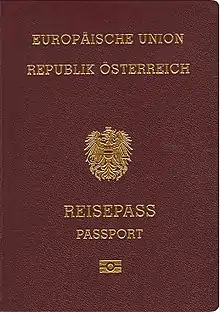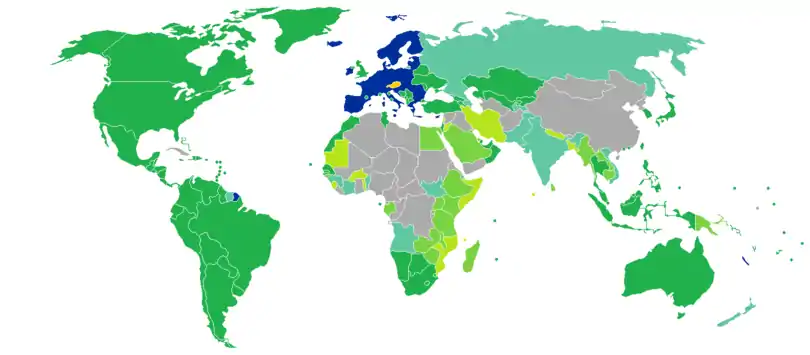Austrian passport
An Austrian passport is issued to citizens of Austria to facilitate international travel. Every Austrian citizen is also a citizen of the European Union. The passport, along with the national identity card allows for free rights of movement and residence in any of the states of the European Economic Area and Switzerland.
| Austrian passport | |
|---|---|
 The front cover of an Austrian biometric passport (2014) | |
 The data page of an Austrian biometric passport (2006) | |
| Type | Passport |
| Issued by | |
| First issued | 16 June 2006[1] (biometric) 5 September 2014[2] (current version) |
| Purpose | Identification |
| Eligibility | Austrian citizenship |
| Expiration | 2 years after issuance for children up to the age of 1; 5 years for children aged 2–11; 10 years for citizens aged 12 and older |
| Cost | €75,90 (aged 12 or over)[3] €30 (aged 0–11)[4] Free (aged 0–2, first issue) |
The application and printing processes of all Austrian passports are handled by the Österreichische Staatsdruckerei (de) headquartered in Vienna. The Österreichische Staatsdruckerei is also tasked with the application and printing processes of the Sovereign Military Order of Malta passport.
Physical appearance
Austrian passports are the same burgundy colour as other European passports, and with the Austrian Coat of arms emblazoned in the centre of the front cover. The words "EUROPÄISCHE UNION" (English: European Union) and "REPUBLIK ÖSTERREICH" (English: Republic of Austria) are inscribed above the coat of arms and the word "REISEPASS" (English: Passport) is inscribed below. Austrian passports have the standard biometric symbol at the bottom and use the standard EU design. Each page of the passport shows the coat of arms of a different Austrian province in the background.
Different spellings of the same name within the same document
German names containing umlauts (ä, ö, ü) and/or ß are spelled in the correct way in the non-machine-readable zone of the passport, but with simple vowel + E and/or SS in the machine-readable zone, e.g. Müller becomes MUELLER, Groß becomes GROSS, and Gößmann becomes GOESSMANN.
The transcription mentioned above is generally used for airplane tickets etc., but sometimes (like in US visas) also simple vowels are used (MULLER, GOSSMANN). The three possible spelling variants of the same name (e.g. Müller / Mueller / Muller) in different documents sometimes lead to confusion, and the use of two different spellings within the same document (like in the passport) may give people who are unfamiliar with the German orthography the impression that the document is a forgery.
Austrian passports may (but do not always) contain a trilingual (in German, English, and French) explanation of the German umlauts and ß, e.g. 'ß' entspricht / is equal to / correspond à 'SS'.
Visa free travel

Visa requirements for Austrian citizens are administrative entry restrictions by the authorities of other states placed on citizens of Austria. As of 7 April 2020, Austrian citizens had visa-free or visa on arrival access to 187 countries and territories, ranking the Austrian passport 5th in the world in terms of travel freedom (tied with Danish passport), according to the Henley Passport Index.[5]
Austrian citizens can live and work in any country within the EU as a result of the right of free movement and residence granted in Article 21 of the EU Treaty.[6]
Holding a second passport
Austria allows its citizens to hold a second Austrian passport to circumvent certain travel restrictions (e.g. some Arab countries do not allow entry with Israeli passport stamps, e.g. Iraq (except Iraqi Kurdistan), Oman and Mauritania).
Holding an Austrian passport and a foreign passport at the same time, i.e. dual citizenship, is restricted under the current Austrian nationality law.
History
Before Austria became a member of the European Union in 1995, passports had a dark green cover.
Image gallery
 Austro-Hungarian Empire passport issued in Bohemia in 1871.
Austro-Hungarian Empire passport issued in Bohemia in 1871. 1936 Austrian stateless passport used for immigrating to British Palestine.
1936 Austrian stateless passport used for immigrating to British Palestine. A contemporary Austrian diplomatic passport.
A contemporary Austrian diplomatic passport.
References
- "Council of the European Union - PRADO - AUT-AO-02001". consilium.europa.eu. Retrieved 2017-08-02.
- "Council of the European Union - PRADO - AUT-AO-02002". consilium.europa.eu. Retrieved 2017-08-02.
- "HELP.gv.at: Reisepass – Neuausstellung". help.gv.at. Retrieved 2017-08-02.
- https://www.henleypassportindex.com/passport-index
- Treaty on the Function of the European Union (consolidated version)